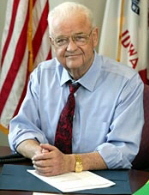Iowa’s Schizophrenic 2010 Electorate
A Democratic majority U.S. House delegation from Iowa is sent to D.C. under historic circumstances in 2011
 Even though each of the individual outcomes were foreseeable – a GOP takeover of the Iowa House of Representatives, the election of Terry Branstad to the governor’s mansion, a Democratic hold in the State Senate, and Democratic victories in their U.S. House seats (all projected by Smart Politics) – taken together, history was made in the Hawkeye State on November 2nd.
Even though each of the individual outcomes were foreseeable – a GOP takeover of the Iowa House of Representatives, the election of Terry Branstad to the governor’s mansion, a Democratic hold in the State Senate, and Democratic victories in their U.S. House seats (all projected by Smart Politics) – taken together, history was made in the Hawkeye State on November 2nd.
A Smart Politics analysis of historical election data finds that Iowans elected a Democratic majority U.S. House delegation to D.C. for the first time in state history when also electing a Republican governor and a GOP majority in the House of Representatives.
Three weeks ago, in the face of a Republican wave that saw more than five dozen seats picked up by the GOP nationwide, Iowans narrowly reelected each of their three Democratic U.S. Representatives in the 1st (Bruce Braley, by 2.1 points), 2nd (David Loebsack, by 5.0 points), and 3rd (Leonard Boswell, pictured above, by 4.0 points) Congressional Districts.
The election of a Democratic majority U.S. House delegation from Iowa is unusual in and of itself – it has occurred only seven times across the previous 77 election cycles since the birth of the Republican Party in the mid-1850s.
Each of these previous instances in which a Democratic-led delegation was sent to Washington occurred during election cycles in which Democrats made gains in the U.S. House nationwide: 1932 (+97 seats), 1934 (+9), 1936 (+12), 1974 (+49), 1976 (+1), 2006 (+31), and 2008 (+21).
But what is even more unusual about 2010 is that Representatives Braley, Loebsack, and Boswell all held their seats while Republicans made such impressive gains up and down the ballot.
For example, on only one prior occasion (1974) have Iowans elected a Republican governor while also electing a majority of their U.S. Representatives from the Democratic Party.
 In 1974’s post-Watergate election cycle, Republican incumbent Robert Ray won his fourth consecutive term, while five of the state’s six U.S. House seats landed in the Democratic column.
In 1974’s post-Watergate election cycle, Republican incumbent Robert Ray won his fourth consecutive term, while five of the state’s six U.S. House seats landed in the Democratic column.
A Democratic sweep in the U.S. House that year was only avoided by Republican Chuck Grassley’s first congressional victory – a 1.6-point win over Stephen Rapp in the 3rd CD’s open seat race. (Current Iowa U.S. Senator Tom Harkin was also elected to Congress for the first time that year).
Republicans also scored huge gains this cycle in the Iowa House of Representatives (winning in a bloodbath as predicted by Smart Politics) – netting 16 seats to turn a 12-seat deficit heading into Election Day (44-56) into a 20-seat advantage (60-40).
Never before in the history of Iowa elections have Republicans won a majority of seats in the Iowa House while Democrats won a majority of the Hawkeye State’s U.S. House seats.
On one occasion – the 47th General Assembly after the 1936 election – Republicans and Democrats tied at 54 seats each in the 108-seat lower chamber, while Democrats won 5 of 9 U.S. House races.
Since the birth of the Republican Party with the 6th General Assembly in 1856, Republicans have won a majority of seats for the Iowa House of Representatives in 66 of 79 election cycles, with Democrats coming out on top just 12 times, with the first not coming until the 1932 Democratic wave.
Taken together, Braley, Loebsack, and Boswell made history – holding their seats in the face of a GOP storming of the State House and the governor’s mansion.
Follow Smart Politics on Twitter.

IMO, the most significant election result from Iowa was the rejection of three incumbent State Supreme Court justices … considering the hard work by Bob Vander Platts to get the message to target the justices and combined that with the attack ads funded by America Future Fund, it is surprising that Bruce Braley survived.
1. Robert Ray served a total of 14 years as governor, the latter eight of them in two four-year terms (KS, SD, and TX also lengthened the terms of their constitutional officers beginning with the post-Watergate ’74 midterm elections).
2. The Hawkeye DEMs will comprise a majority of the state’s US House delegation come early January of ’19, a half-dozen years after Des Moines-based REP Boswell somewhat unexpectedly lost in a member-v-member matchup. Long term, though, it would be a minor miracle if they manage to sustain their dominant position, not so much because of the pro-abolition and -homestead mindset of the state’s distant past, but because of its metro/rural mix, Caucasian-v-nonCaucasian composition, primary economic engine, education level, and other factors.
RE: Robert Ray – Iowa is the only state that has produced two statehood governors who served 14 or more years. [Though Ray technically served 13 years, 11 months, 30 days; #16 all-time].